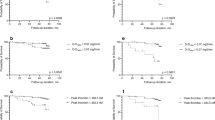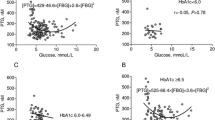Abstract
Microalbuminuria and haemostasis derangements have been considered as independent risk factors for cardiovascular death in type 2 (non-insulin-dependent) diabetic patients. Few studies have assessed coagulation inhibitors in type 2 diabetic patients with normoalbuminuria and microalbuminuria. Therefore, 32 type 2 diabetic patients with normoalbuminuria (albumin excretion rate, AER<20 mg/min, mean 7±1) and 28 type 2 diabetic patients with microalbuminuria (AER 20–200 mg/min, mean 84±11) were studied. The patients were matched for age, sex, disease duration and treatment, body mass index (BMI), blood pressure and glycohaemoglobin. Protein C and S activity, antithrombin III, thrombomodulin and prothrombin fragments 1+2 (F 1+2) were assessed together with fibrinogen, triglycerides, total and high density lipoprotein (HDL)-cholesterol concentrations. Fibrinogen, total and low density lipoprotein (LDL) concentrations were similar in the two groups, while a significant difference was observed for triglycerides (normoalbuminuric group: 128±10 mg/dl, microalbuminuric group: 184.1±17 mg/dl;P<0.007) and HDL-cholesterol (normoalbuminuric group: 45±2 mg/dl, microalbuminuric group: 39±2 mg/dl;P<0.05). The coagulation parameters were as follows: normoalbuminuric group: protein C activity 109%±5%, protein S 95.4%±5%, thrombomodulin 49.3±3 ng/ml, antithrombin III 93.3%±3%, F 1+2 1.05±0.04 nmol/l; microalbuminuric group: protein C activity 107%±4%, protein S 98.4%±4%, thrombomodulin 64.4±4 ng/ml, antithrombin III 93.3%±3%, F 1+2 1.03±0.05 nmol/l. The difference was significant for thrombomodulin (P<0.007). A significant direct correlation was observed in the microalbuminuric group between AER and thrombomodulin (r=0.38,P<0.05). In conclusion, our data do not support the hypothesis that a reduction in the activity of anticoagulant physiological inhibitors (protein C, protein S, antithrombin III) could contribute to explain the higher cardiovascular risk in type 2 diabetic patients with microalbuminuria. The elevation of plasma thrombomodulin concentration in type 2 diabetic patients could be the consequence of widespread vascular damage in diabetic patients with incipient nephropathy.
Similar content being viewed by others
References
Morrish NJ, Stevens LK, Head J, Fuller JH, Jarret RJ, Keen H, A prospective study of mortality among middle-aged diabetic patients (the London cohort of the WHO Multinational Study of Vascular Disease in Diabetics) I: causes and death rates. Diabetologia 33:538–541, 1990
Fuller JH, Keen H, Jarret RJ, Omer T, Meade T, Chakrabarti R, North WRS, Stirling Y, Haemostatic variables associated with diabetes and its complications. Br Med J 2:964–966, 1979
Deckert T, Kofoed-Enevoldsen A, Norgaard K, Borch-Johnsen K, Feldt-Rasmussen B, Jensen T, Microalbuminuria: implication for micro- and macrovascular disease. Diabetes Care 9: 1181–1191, 1992
Kwaan HC, Changes in blood coagulation, platelet function, and plasminogen-plasmin system in diabetes. Diabetes 35:617–619, 1986
Schmitz A, Ingerslev J, Haemostatic measures in type 2 diabetic patients with microalbuminuria. Diabetic Med 7:521–525, 1990
Knöbl P, Schernthaner G, Schnack C, Pietschmann P, Griesmacher A, Prager R, Müller M, Thrombogenic factors are related to urinary albumin excretion rate in type 1 (insulin-dependent) and type 2 (non0insulin-dependent) diabetic patients. Diabetologia 36:1045–1050, 1993
Veglio M, Gruden G, Mormile A, Girotto M, Rossetto P, D'Este P, Cavallo-Perin P, Anticoagulant protein C activity in non-insulin-dependent diabetic patients with normoalbuminuria and microalbuminuria. Acta Diabetol 32:106–109, 1995
Teitel JM, Bauer KA, Lau HK, Rosenberg RD, Studies of the prothrombin activation pathway utilizing radioimmunoassays for the F2/F1+2 fragment and thrombin-antithrombin complex. Blood 59:1086, 1982
Martinoli JR, Stocker K, Fast functional protein C assay using Protac, a novel protein C activator. Thromb Res 43:253–264, 1986
Wolf M, Bover-Neuman C, Martinoli JR, Amiral J, Meyer D, Larrieu MJ, A new functional assay for human protein S using activated factor V as substrate. Thromb Haemost 62:1144–1145, 1989
Claus A, Measurement of fibrinogen. Acta Haematol 17:237–242, 1957
Baker IA, Eastham R, Elwood PC, Ethrington M, O'Brien JR, Sweetnam PM, Haemostatic factors associated with ischemic heart disease in men aged 45 to 64 years. Br Heart J 47:490–494, 1982
Yarnell JWG, Sweetnam PM, Elwood PC, Eastham R, Gilmour RA, O'Brien JR, Ethrington MD, Haemostasis factors and ischaemic heart disease: the Caerphilly study. Br Heart J 53: 483–487, 1985
Iwashima Y, Sato T, Watanabe K, Ooshima E, Hiraishi S, Ishii H, Kazama M, Makino I, Elevation of plasma thrombomodulin level in diabetic patients with early diabetic nephropathy. Diabetes 39:983–988, 1990
Vukovich TC, Schernthaner G, Decreased protein C levels in patients with insulin-dependent type I diabetes mellitus. Diabetes 35:617–619, 1986
Viganò S, Mannucci PM, D'Angelo A, Gelfi C, Gensini GF, Rostagno C, Neri Serneri GG, Protein C antigen is not an acute phase reactant and is often high in ischemic heart disease and diabetes. Thromb Haemost 52:263–266, 1984
Ceriello A, Quatraro A, Dello Russo P, Marchi E, Barbanti M, Milani MR, Giugliano D, Protein C deficiency in insulin dependent diabetes: a hyperglycemia-related phenomenon. Thromb Haemost 64:104–107, 1990
Biondi G, Sorano GG, Conti M, Mameli G, Cirillo R, Marongui F, The behaviour of protein C is still an open question. Thromb Haemost 66:267, 1991
Schernthaner G, Vukovich T, Knobl P, Hay U, Muller MM, The effect of near normoglycaemic control on plasma levels of coagulation factor VII and the anticoagulant protein C and S in insulin-dependent diabetic patients. Br J Haematol 73:356–359, 1989
Takahashi H, Tatewaki W, Wada K, Shibata A, Plasma protein S in disseminated intravascular coagulation, liver disease, collagen disease, diabetes mellitus, and under oral anticoagulant therapy. Clin Chim Acta 182:195–208, 1989
Garcìa Frade LJ, De la Calle H, Torrado MC, Lara JL, Cuaellar L, Garcìa Avello A, Hypofibrinolysis associated with vasculopathy in non insulin dependent diabetes mellitus. Thromb Res 59:51–59, 1990
Carmassi F, Morale M, Puccetti R, De Negri F, Monzani F, Navalesi R, Mariani G, Coagulation and fibrinolytic system impairment in insulin dependent diabetes mellitus. Thromb Res 67: 643–654, 1992
Brownlee M, Cerami A, Vlassara H, Advanced products of non enzymatic glycosylation and the pathogenesis of diabetic vascular disease. Diabetes Metab Rev 4:437–451, 1988
Patrassi GM, Picchienna R, Vettor R, Cappellatto G, Coccarielli A, Girolami A, Antithrombin III activity and concentration in diabetes mellitus. Thromb Haemost 54:415–517, 1985
Ceriello A, Dello Russo P, Zuccotti C, Florio A, Nazzaro S, Pietrantuono C, Rosato GB, Decreased antithrombin III activity in diabetes may be due to non enzymatic glycosylation. A preliminary report. Thromb Haemost 50:633–634, 1983
Ceriello A, Giuliano D, Quatraro A, Stante A, Consoli G, Dello Russo P, D'Onofrio F, Daily rapid blood glucose variations may condition antithrombin III biologic activity but not its plasma concentration in insulin-dependent diabetes. A possible role for liable non-enzymatic glycation. Diabetes Metab 13:16–19, 1987
Ceriello A, Giuliano D, Quatraro A, Stante A, Consoli G, Dello Russo P, D'Onofrio F, Induced hyperglycemia alters antithrombin III activity but not its plasma concentration in healthy normal subjects. Diabetes 36:320–323, 1987
Deckert T, Feldt-Rasmussen B, Borch-Johensen K, Jensen T, Kofoed-Enevoldsen A, Albuminuria reflects widespread vascular damage. The Steno hypothesis. Diabetologia 32:219–226, 1989
Gruden G, Bazzan M, Stella S, Pagano G, Pileri A, Cavallo-Perin P, Microalbuminuria in insulin-dependent diabetes is associated with highe levels of prothrombin fragment 1+2. Thromb Res 72:541–546, 1993
Gruden G, Cavallo-Perin P, Romagnoli R, Olivetti C, Frezet D, Pagano G, Prothrombin fragment F 1+2 and antithrombin III-thrombin complex in microalbuminuric type 2 diabetic patients. Diabetic Med 11:485–488, 1994
Author information
Authors and Affiliations
Rights and permissions
About this article
Cite this article
Mormile, A., Veglio, M., Gruden, G. et al. Physiological inhibitors of blood coagulation and prothrombin fragment F 1+2 in type 2 diabetic patients with normoalbuminuria and incipient nephropathy. Acta Diabetol 33, 241–245 (1996). https://doi.org/10.1007/BF02048551
Received:
Accepted:
Issue Date:
DOI: https://doi.org/10.1007/BF02048551




